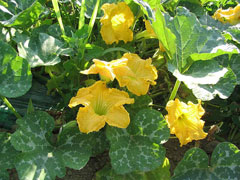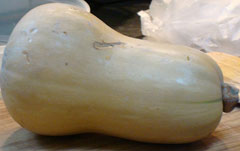 |
|
http://fr.wikipedia.org/wiki/Utilisateur:Jeantosti |
 |
| http://commons.wikimedia.org/wiki/User:Tanzania |
Translate this page:
Summary
Physical Characteristics

 Cucurbita moschata is a ANNUAL CLIMBER growing to 0.6 m (2ft) by 4 m (13ft 1in) at a fast rate.
Cucurbita moschata is a ANNUAL CLIMBER growing to 0.6 m (2ft) by 4 m (13ft 1in) at a fast rate.
See above for USDA hardiness. It is hardy to UK zone 3 and is frost tender. It is in flower from July to September, and the seeds ripen from August to October. The species is monoecious (individual flowers are either male or female, but both sexes can be found on the same plant) and is pollinated by Insects. The plant is self-fertile.
Suitable for: light (sandy), medium (loamy) and heavy (clay) soils and prefers well-drained soil. Suitable pH: mildly acid, neutral and basic (mildly alkaline) soils. It can grow in semi-shade (light woodland) or no shade. It prefers moist soil.
UK Hardiness Map
US Hardiness Map
Synonyms
Plant Habitats
Cultivated Beds;
Edible Uses
Edible Parts: Flowers Fruit Leaves Oil Seed
Edible Uses: Oil
Fruit - cooked[2, 27, 46, 105]. Some cultivars have a delicious flavour when baked, rather like a sweet potato[K]. The flesh can be dried and ground into a powder then used in making breads etc[183]. Some varieties can be stored for up to 9 months. Seed - raw or cooked[57, 86, 105]. Rich in oil with a pleasant nutty flavour[183] but very fiddly to use because the seed is small and covered with a fibrous coat[K]. An edible oil is obtained from the seed[183]. Leaves and young stems - cooked and used as a potherb or added to soups, stews etc[105, 135, 183]. Flowers - cooked[105, 135, 183].
References More on Edible Uses
Medicinal Uses
Plants For A Future can not take any responsibility for any adverse effects from the use of plants. Always seek advice from a professional before using a plant medicinally.
Anthelmintic Galactogogue
The seed is vermifuge[147]. It is eaten fresh or roasted for the relief of abdominal cramps and distension due to intestinal worms[218]. About 800 peeled seeds is said to make a safe and effective treatment for tape worm[218]. They are ground into a fine flour, then made into an emulsion with water and eaten. It is then necessary to take a purge in order to expel the tapeworms or other parasites from the body[7]. The boiled root is galactogogue[218].
References More on Medicinal Uses
The Bookshop: Edible Plant Books
Our Latest books on Perennial Plants For Food Forests and Permaculture Gardens in paperback or digital formats.

Edible Tropical Plants
Food Forest Plants for Hotter Conditions: 250+ Plants For Tropical Food Forests & Permaculture Gardens.
More

Edible Temperate Plants
Plants for Your Food Forest: 500 Plants for Temperate Food Forests & Permaculture Gardens.
More

More Books
PFAF have eight books available in paperback and digital formats. Browse the shop for more information.
Shop Now
Other Uses
Oil
An edible oil is obtained from the seed[183].
Special Uses
References More on Other Uses
Cultivation details
Requires a rich, well-drained moisture retentive soil and a very warm, sunny and sheltered position[1, 37, 86]. Prefers a pH of 5.5 to 5.9, but tolerates up to 6.8[86]. Moderate rainfall favours growth, but the roots of most cultivars are sensitive to high soil-water levels[200]. The squash is a frost-tender annual plant that is widely cultivated, especially in warm temperate and tropical areas, for its edible fruit[27]. There are very many named varieties widely differing in size shape and taste[27, 183]. Some varieties are used in the summer and autumn whilst others are harvested in the autumn and can be stored for several months. Succeeds outdoors most years in Britain[27]. Plants are more suited to warmer climates than Britain[200] and are only really successful in good summers in this country, they do not do well in the north[86]. Most cultivars are day-length neutral[200]. This species only hybridizes with other members of the genus under controlled conditions[86, 135]. Grows well with sweetcorn, radishes and nasturtium but dislikes potatoes[18, 20]. Squashes and pumpkins can be differentiated from each other by their fruit stalk, it is angular and polygonal in pumpkins but thick, soft and round in squashes[132].
References Carbon Farming Information and Carbon Sequestration Information
Temperature Converter
Type a value in the Celsius field to convert the value to Fahrenheit:
Fahrenheit:
The PFAF Bookshop
Plants For A Future have a number of books available in paperback and digital form. Book titles include Edible Plants, Edible Perennials, Edible Trees,Edible Shrubs, Woodland Gardening, and Temperate Food Forest Plants. Our new book is Food Forest Plants For Hotter Conditions (Tropical and Sub-Tropical).
Shop Now
Plant Propagation
Seed - sow early to mid spring in a greenhouse in a rich soil. Germination should take place within 2 weeks. Sow 2 or 3 seeds per pot and thin out to the best plant. Grow them on fast and plant out after the last expected frosts, giving them cloche or frame protection for at least their first few weeks if you are trying them outdoors.
Other Names
If available other names are mentioned here
Native Range
Coming Soon
Weed Potential
Right plant wrong place. We are currently updating this section.
Please note that a plant may be invasive in one area but may not in your area so it's worth checking.
Conservation Status
IUCN Red List of Threatened Plants Status :

| Related Plants
|
| Latin Name | Common Name | Habit | Height | Hardiness | Growth | Soil | Shade | Moisture | Edible | Medicinal | Other |
| Abobra tenuifolia | Cranberry Gourd | Perennial Climber | 3.5 |
8-11
| | LM | N | DM | 1 | 0 | |
| Acanthosicyos horridus | Naras. Butterpips | Perennial | 1.0 |
9-11
| F | LM | N | DM | 3 | 2 | 2 |
| Apodanthera undulata | Loco Melon | Perennial Climber | 2.0 |
8-10
| M | LM | N | DM | 1 | 0 | 2 |
| Benincasa hispida | Wax Gourd | Annual | 6.0 |
9-11
| | LMH | N | M | 3 | 3 | 1 |
| Bryonia alba | White Bryony | Perennial Climber | 4.0 |
5-9
| F | LMH | SN | M | 1 | 2 | 0 |
| Bryonia dioica | Red Bryony, Cretan bryony | Perennial Climber | 3.5 |
5-9
| F | LMH | SN | M | 1 | 2 | |
| Citrullus colocynthis | Perennial egusi, Bitter-apple | Perennial | 3.0 |
10-12
| F | LM | N | DM | 3 | 2 | 3 |
| Citrullus lanatus | Water Melon | Annual | 0.5 |
8-11
| | LM | N | DM | 4 | 3 | 1 |
| Coccinia grandis | Ivy Gourd | Perennial | 3.0 |
8-11
| | LMH | N | M | 2 | 2 | 0 |
| Cucumis anguria | Gherkin, West Indian gherkin | Annual Climber | 2.4 |
9-11
| | LMH | N | M | 3 | 1 | 0 |
| Cucumis melo | Melon, Cantaloupe | Annual Climber | 1.5 |
9-11
| | LMH | N | M | 4 | 2 | 0 |
| Cucumis melo agrestis | Wild Melon | Annual Climber | 1.5 |
9-11
| | LMH | N | M | 3 | 2 | |
| Cucumis melo cantalupensis | Cantaloupe Melon | Annual Climber | 1.5 |
9-11
| | LMH | N | M | 4 | 2 | |
| Cucumis melo chito | Orange Melon | Annual Climber | 1.5 |
9-11
| | LMH | N | M | 3 | 2 | |
| Cucumis melo conomon | Pickling Melon | Annual Climber | 1.5 |
9-11
| | LMH | N | M | 4 | 2 | |
| Cucumis melo flexuosus | Serpent Melon | Annual Climber | 1.5 |
9-11
| | LMH | N | M | 4 | 2 | |
| Cucumis melo inodorus | Honeydew Melon | Annual Climber | 1.5 |
9-11
| | LMH | N | M | 4 | 2 | |
| Cucumis melo momordica | Snap Melon | Annual Climber | 1.5 |
9-11
| | LMH | N | M | 4 | 2 | |
| Cucumis metuliferus | Horned Cucumber, African horned cucumber | Annual Climber | 1.5 |
9-11
| | LMH | N | M | 2 | 2 | 1 |
| Cucumis sativus | Cucumber, Garden cucumber | Annual Climber | 2.0 |
9-11
| | LMH | N | M | 4 | 2 | 2 |
| Cucurbita argyrosperma | Cushaw Pumpkin | Annual Climber | 0.5 |
2-11
| | LMH | SN | M | 4 | 2 | 1 |
| Cucurbita digitata | Coyote Gourd | Perennial | 5.0 |
10-12
| M | LMH | N | DM | 3 | 0 | 3 |
| Cucurbita ficifolia | Malabar Gourd, Figleaf gourd | Perennial Climber | 0.0 |
9-11
| F | LMH | SN | MWe | 3 | 2 | 1 |
| Cucurbita foetidissima | Buffalo Gourd, Missouri gourd | Perennial Climber | 6.0 |
6-11
| F | LMH | SN | DM | 3 | 2 | 3 |
| Cucurbita maxima | Winter Squash | Annual Climber | 0.6 |
2-11
| F | LMH | SN | M | 5 | 3 | 2 |
| Cucurbita pepo | Pumpkin, Field pumpkin, Ozark melon, Texas gourd | Annual Climber | 0.6 |
2-11
| F | LMH | SN | M | 4 | 3 | 2 |
| Cyclanthera brachystachya | Cuchinito | Annual | 3.0 |
9-11
| | LMH | S | M | 1 | 0 | |
| Cyclanthera pedata | Achocha, Caihua, Caygua, Cayua, Korila, Wild Cucumber | Annual | 4.5 |
9-11
| F | LMH | SN | M | 3 | 4 | 1 |
| Ecballium elaterium | Squirting Cucumber | Perennial | 0.3 |
8-11
| | LMH | N | DM | 0 | 2 | |
|
|
Growth: S = slow M = medium F = fast. Soil: L = light (sandy) M = medium H = heavy (clay). pH: A = acid N = neutral B = basic (alkaline). Shade: F = full shade S = semi-shade N = no shade. Moisture: D = dry M = Moist We = wet Wa = water.
Now available:
Food Forest Plants for Mediterranean Conditions
350+ Perennial Plants For Mediterranean and Drier Food Forests and Permaculture Gardens.
[Paperback and eBook]
This is the third in Plants For A Future's series of plant guides for food forests tailored to
specific climate zones. Following volumes on temperate and tropical ecosystems, this book focuses
on species suited to Mediterranean conditions—regions with hot, dry summers and cool, wet winters,
often facing the added challenge of climate change.
Read More
Expert comment
Author
(Duchesne. ex Lam.)Duchesne. ex Poir.
Botanical References
200
Links / References
For a list of references used on this page please go here
Readers comment